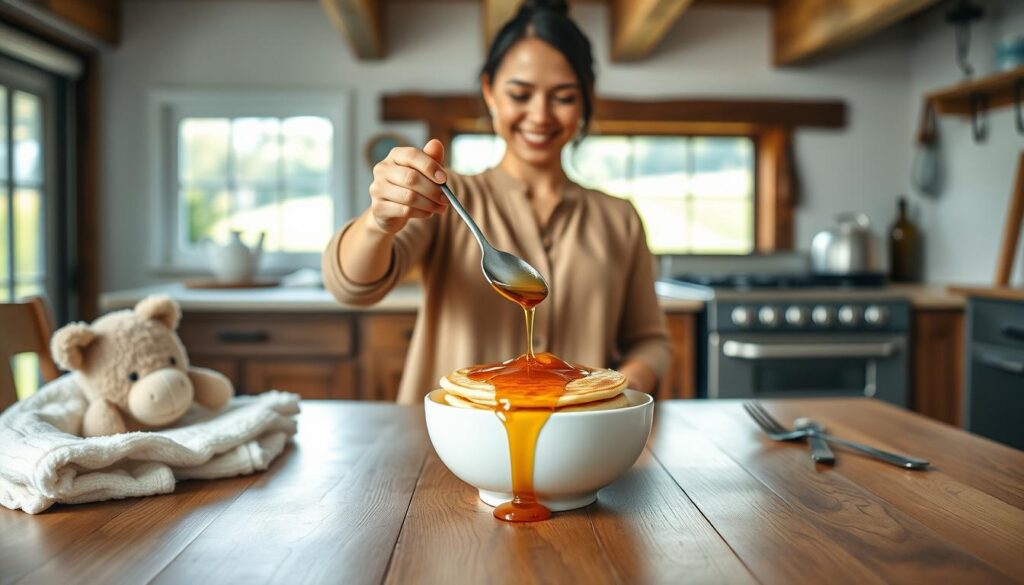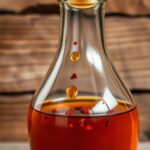Parents often ask about introducing new foods to their baby’s diet. Maple syrup is a common topic of concern. Experts say it’s not as simple as it seems.
Is maple syrup safe for infants? The answer is no for babies under 12 months. Their immune systems are not ready to handle the risks of maple syrup.
Can babies have maple syrup after their first birthday? Maybe, but only a little. Always check with your pediatrician first. Every baby is different, and so are their needs.
There are big concerns with maple syrup and babies. These include botulism risk, too much sugar, and allergies. Babies’ stomachs are very sensitive. Parents need to be careful with what they feed them.
This guide will help you understand the safety of maple syrup for babies. We’ll look at expert advice and what you need to know. This way, you can make the best choices for your baby’s diet.
Understanding Maple Syrup: Natural Sweetener Overview
Maple syrup is a fascinating natural sweetener with a rich history and nutritional value. It’s a unique food that offers more than just sweetness for toddlers.
Maple syrup is a minimally processed, nutrient-rich sweetener made from maple tree sap. It contains essential minerals and compounds. This makes it a great choice for families looking for healthier alternatives.
Exploring Maple Syrup Varieties
Different maple syrup grades have unique characteristics and flavors:
- Golden Color, Delicate Taste: Lightest grade, perfect for subtle sweetening
- Amber Color, Rich Taste: Medium-intensity flavor with balanced sweetness
- Dark Color, Robust Taste: Strongest maple flavor, most mineralized
Nutritional Profile
Natural sweeteners for infants need careful thought. Maple syrup has trace minerals like:
- Manganese
- Zinc
- Calcium
- Potassium
Processing and Purity Standards
High-quality maple syrup is processed minimally. Sugarmakers collect sap, boil it, and filter the syrup. This creates a pure, natural product without artificial additives.
Pure maple syrup represents nature’s original sweetener, crafted through generations of traditional techniques.
Age Recommendations for Introducing Maple Syrup
Parents often ask when to introduce maple syrup to babies. Experts say wait until a child is at least 12 months old. This ensures their digestive system can handle complex sugars safely.
Deciding when to introduce maple syrup to babies involves several factors:
- Digestive maturity of the infant
- Risk of botulism
- Potential allergic reactions
- Nutritional needs of the child
The first year is key for healthy eating habits. Maple syrup is not a must for infants. Doctors warn against adding sugars, including maple syrup, in the first 12 months.
Babies need breast milk or formula as their main food in the first year.
When introducing maple syrup, follow these steps:
- Wait until the child is at least 12 months old
- Start with small amounts
- Watch for any allergic signs
- Choose pure, organic maple syrup
- Always check with a pediatrician first
Nutrition experts say maple syrup has minerals but should not replace other foods. Parents should focus on balanced nutrition and slow dietary changes.
Can Babies Have Maple Syrup: Expert Guidelines
Choosing the right foods for babies is very important. Parents often ask if maple syrup is safe for their little ones. They look for expert advice to make the best choices.
Doctors have clear guidelines on maple syrup for babies. They focus on health risks and when babies are ready for new foods.
Medical Professionals’ Recommendations
Pediatric nutritionists say no to maple syrup for babies under 12 months. Is maple syrup safe for infants? No, for babies under one year, it’s not recommended.
- Avoid maple syrup for babies under 12 months
- Wait until after the first birthday for introduction
- Consult with your pediatrician before adding any new food
Safety Considerations for Infants
There are important safety points to think about when considering maple syrup for babies. Pure maple syrup has natural sugars. These can be hard for a baby’s growing digestive system.
- Risk of botulism in unpasteurized maple syrup
- Potential choking hazard
- High sugar content inappropriate for infants
Signs of Readiness for Maple Syrup
Parents should look for certain signs that their child is ready for maple syrup:
- Ability to eat solid foods consistently
- No existing food allergies
- Good overall digestive health
- Pediatrician’s approval
Always introduce new foods gradually and in minimal amounts, monitoring for any adverse reactions.
Potential Risks of Giving Maple Syrup to Babies
Parents often ask: is maple syrup safe for infants? It’s a question that needs careful thought. Maple syrup might seem natural, but it’s not safe for babies under one year old.
Pediatric nutrition experts advise against giving maple syrup to infants. They point out several health risks:
- Risk of infant botulism
- High sugar content
- Potential allergic reactions
- Dental health complications
The main worry is the risk of bacterial contamination. Raw or unpasteurized maple syrup can have Clostridium botulinum spores. These spores are very dangerous for babies’ young immune systems.
“Never introduce maple syrup to infants under 12 months without consulting your pediatrician” – American Academy of Pediatrics
There are also nutritional risks. Maple syrup’s high sugar can harm babies’ taste buds. It might also lead to dietary problems later on.
| Age Group | Maple Syrup Risk Level | Recommended Action |
|---|---|---|
| 0-12 months | High Risk | Avoid completely |
| 12-24 months | Moderate Risk | Consult pediatrician, use sparingly |
| 2+ years | Low Risk | Moderate consumption acceptable |
Knowing these risks helps parents make better choices for their baby’s diet. It ensures their baby stays safe and healthy.
Safe Alternatives to Maple Syrup for Infants
Parents looking for safe sweeteners for their babies have many options. It’s important to think about the baby’s age, nutritional needs, and any allergies.
- Mashed ripe fruits
- Pureed bananas
- Applesauce without added sugar
- Baked sweet potato
- Pureed pears
Natural Sweetening Options
Choosing natural sweeteners for babies means picking whole foods. Fruits are the best natural sweeteners for babies. They add flavor and important nutrients.
Age-Appropriate Substitutes
Introducing sweet flavors should match the baby’s age. For babies 6-12 months, try these gentle options:
- Pureed fruits
- Mashed ripe berries
- Roasted squash
- Cooked carrots
Homemade Baby Food Ideas
Making baby food at home lets you control what goes in. Simple recipes like fruit purees or vegetable mashes are sweet without added sugars.
Always check with a pediatrician before adding new foods to a baby’s diet.
How to Safely Introduce Maple Syrup to Your Baby’s Diet
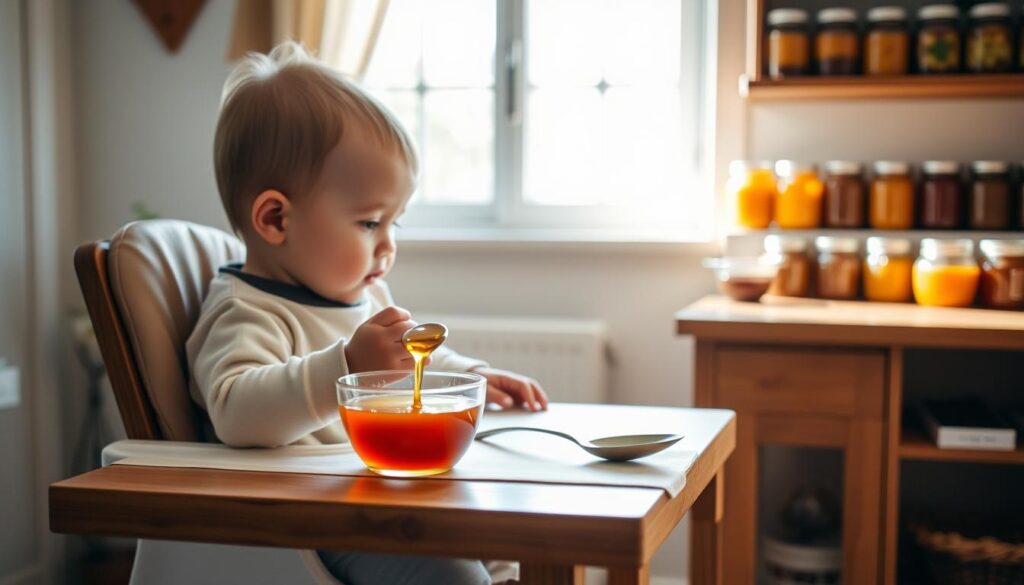
Parents thinking about maple syrup for their baby’s food need to be careful. It’s important to know when to start maple syrup with babies. This requires patience and understanding of what babies need to eat.
It’s best to add maple syrup slowly and carefully. Doctors say to wait until a baby is at least 12 months old. This age is important because the baby’s body can handle natural sweeteners better.
- Wait until baby is 12+ months old
- Start with minimal quantities
- Choose pure, organic maple syrup
- Monitor for possible allergic reactions
When you’re ready to add maple syrup to your baby’s food, start with a little. Experts say to use no more than 1/4 teaspoon at a time. Mix it into foods like oatmeal or yogurt to slowly introduce the taste.
“Always consult your pediatrician before introducing any new food to your infant’s diet.” – American Academy of Pediatrics
Be on the lookout for any signs of trouble. Things like skin rashes, tummy issues, or changes in how they eat could mean they’re not okay with maple syrup.
- Do a small test on their skin first
- Introduce one new food at a time
- Wait 3-5 days before trying another new food
- Keep a food diary to track any reactions
Choosing the right maple syrup is key. Look for organic, single-source syrup without added sugars or preservatives. This ensures the safest start for your baby with maple syrup.
Signs of Maple Syrup Allergies in Babies
Maple syrup allergies in babies can be hard to spot. Though rare, they need quick action. Knowing the signs helps keep babies safe and get help fast.
Common Allergic Reactions
Babies with maple syrup allergies might show certain signs:
- Skin rashes or hives
- Swelling around mouth or face
- Digestive discomfort
- Respiratory difficulties
- Unusual crying or irritability
The severity of these allergies can differ. Some babies might have mild reactions, while others could face serious symptoms needing quick medical help.
When to Contact Your Pediatrician
Call your pediatrician right away if your baby shows these signs after eating maple syrup:
| Symptom | Action Required |
|---|---|
| Difficulty breathing | Urgent medical care |
| Severe skin reactions | Immediate pediatric evaluation |
| Persistent vomiting | Medical consultation |
| Significant swelling | Emergency medical assessment |
Watching closely and acting fast can stop serious problems from maple syrup allergies in babies. Always talk to doctors for advice that fits your baby’s needs.
Best Practices for Using Maple Syrup in Baby Food
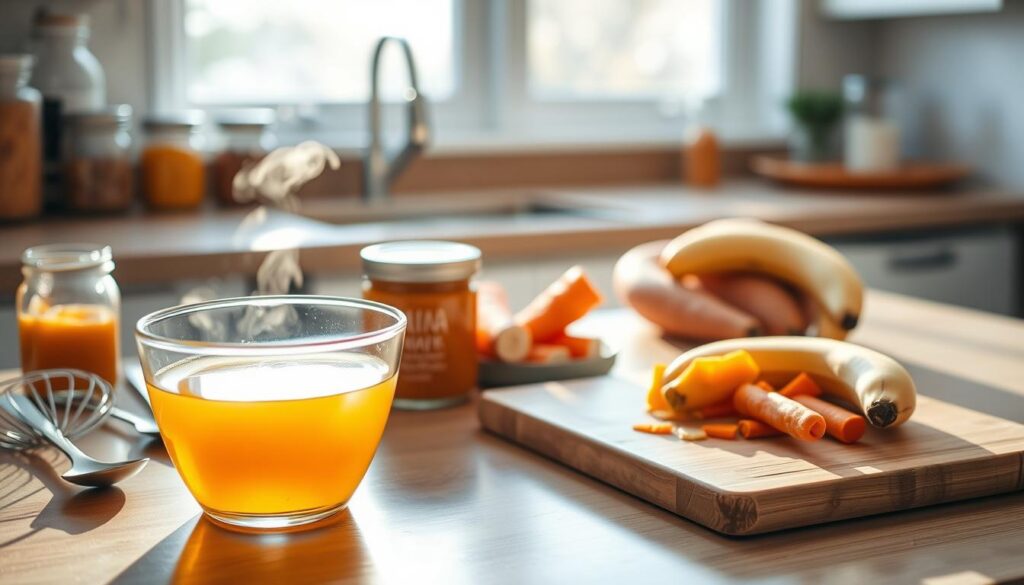
Parents looking to add maple syrup to baby food should know how to do it right. Maple syrup can be a healthy choice for homemade baby food if used wisely.
Here are key tips for adding maple syrup to baby food:
- Wait until the baby is at least 12 months old before introducing maple syrup
- Use pure, organic maple syrup without added preservatives
- Start with minimal quantities – no more than 1-2 teaspoons per serving
- Choose lighter maple syrup grades for milder flavor profiles
Integrating maple syrup into baby food requires careful thought. Here are some ways to do it well:
- Mixing small amounts into pureed fruits
- Drizzling lightly over cooked grains
- Adding to yogurt-based recipes
- Blending into oatmeal or other soft cereals
Nutritionists say to use maple syrup sparingly in baby food. It has trace minerals like zinc and manganese. This makes it a good choice when used in small amounts.
Always consult your pediatrician before introducing new foods to your infant’s diet.
Comparing Pure Maple Syrup vs. Artificial Alternatives
Parents looking for natural sweeteners for their toddlers often compare pure maple syrup and artificial alternatives. Knowing the differences helps make better choices for their kids’ nutrition.
Pure maple syrup beats artificial sweeteners in many ways. When picking a sweetener for toddlers, parents should look at a few important things:
- Natural ingredient profile
- Nutritional value
- Processing methods
- Potential health impacts
Understanding Label Claims
Reading product labels carefully is key. Real maple syrup products usually show what makes them different from fake ones.
| Characteristic | Pure Maple Syrup | Artificial Alternatives |
|---|---|---|
| Ingredients | 100% maple sap | Corn syrup, artificial flavors |
| Nutritional Value | Minerals, antioxidants | Limited nutritional benefits |
| Processing | Minimal processing | Heavy industrial refinement |
Making Informed Choices
Parents should choose natural, minimally processed options for their toddlers. Pure maple syrup is a better choice than artificial sweeteners. It has nutrients and tastes more natural.
It’s wise to check ingredient lists and understand nutritional content. Also, talking to pediatric nutritionists can help figure out when to introduce pure maple syrup to toddlers.
Storing and Handling Maple Syrup for Baby Food Safety
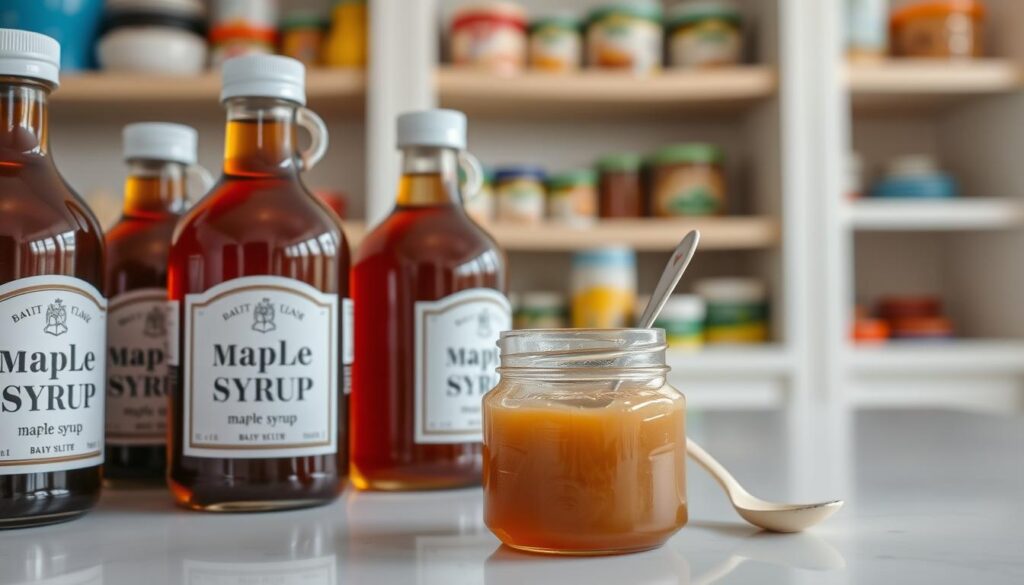
Storing maple syrup right is key for baby food safety. Parents need to know how to keep this natural sweetener fresh. This ensures their baby gets the best nutrition.
Refrigeration is the best way to store maple syrup for baby food. Keep unopened syrup in a cool, dark place. But once you open it, put it in the fridge to stop it from spoiling.
- Keep maple syrup in a tightly sealed glass or food-grade container
- Store in the refrigerator after opening
- Check for signs of mold or unusual odors before use
The shelf life of maple syrup depends on how you store it. If you keep it in the fridge, it can last up to a year. For baby food, use small amounts to avoid contamination risks.
Watch out for these signs when using maple syrup for baby food:
- Crystallization at the bottom of the container
- Cloudy appearance
- Unusual smell or color changes
Always use clean utensils when handling maple syrup to prevent bacterial growth. Use a small amount for baby food and avoid touching the main container.
Food safety experts recommend careful handling of all sweet additions to infant diets.
Choosing the right maple syrup is vital for baby food. Opt for organic, single-source syrups with little processing. This ensures the safest choice for your baby.
Common Mistakes Parents Make with Maple Syrup
Understanding infant nutrition can be tough, like figuring out if babies can have maple syrup. Many parents make mistakes that could harm their child’s health and growth.
Exploring maple syrup for babies often leads to common errors:
- Introducing maple syrup too early in an infant’s diet
- Using unfiltered or unpasteurized maple syrup
- Overusing maple syrup as a sweetener
- Misunderstanding portion sizes for infants
Pediatric nutrition experts stress caution with maple syrup for babies. A big mistake is treating maple syrup like regular sugar, which can be harmful.
“Always consult with your pediatrician before introducing any new food to your baby’s diet.” – American Academy of Pediatrics
Parents should know the risks of maple syrup for infants:
- Risk of botulism in raw or unprocessed maple syrup
- Potential allergic reactions
- High sugar content not good for infant nutrition
- Digestive system not ready
Knowing these mistakes helps parents make better choices about maple syrup for their babies. It’s important to do research and get advice from doctors.
Research-Based Evidence on Maple Syrup and Infant Nutrition
Nutritional research is looking into natural sweeteners for babies, with maple syrup being a key focus. Parents who want to know if maple syrup is safe for their babies can look at recent studies and expert advice.

Recent studies have given us a better understanding of maple syrup and baby diets. Scientists have done a lot of research to see if natural sweeteners are good for young children’s diets.
Latest Scientific Findings
- Nutritional analysis shows maple syrup has trace minerals like zinc and manganese
- Research points to possible antioxidant benefits in pure maple syrup
- Studies warn of caution when adding new foods to a baby’s diet
Expert Nutritional Perspectives
Pediatric nutritionists suggest being careful with natural sweeteners like maple syrup. They agree that babies should be at least 12 months old before trying maple syrup.
| Research Focus | Key Findings | Recommended Age |
|---|---|---|
| Nutritional Content | Trace minerals present | 12+ months |
| Potential Benefits | Antioxidant properties | Limited consumption |
| Safety Considerations | Minimal processing recommended | Pediatrician consultation |
As research goes on, parents should always get advice from doctors. Adding maple syrup to a baby’s diet needs careful thought about their health and age.
Pediatric experts stress the importance of consulting healthcare professionals before introducing any new food to an infant’s diet.
Conclusion
Knowing when to introduce maple syrup to babies is important. Parents need to think carefully and get advice from doctors. It’s not just about adding a sweetener to their diet.
The right time to give maple syrup to babies depends on their age and health. Doctors say it’s best to wait until they are at least a year old. This ensures their body can handle it safely.
Being a responsible parent means knowing the risks and benefits. Maple syrup has some good stuff in it, but too much is not good. It’s all about finding the right balance and watching for any signs of allergy.
Good parenting means doing your homework and listening to experts. With the right information and caution, you can decide if maple syrup is right for your baby. Always put your child’s health first.

